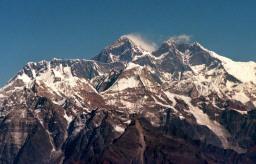Three Italian mountaineers on Thursday completed the installation of the world's highest climate station, on Mt Everest.
Working in extremely tough weather conditions, Silvio Mondinelli, Michele Enzio and Marco Confortola screwed in the final pieces of the station 8,000m above sea level on the 'Edmund Hillary' South Col of the mountain.
Italian scientists and mountaineers have developed the station over the last two years as part of a project to see whether weather conditions in the Himalayas are changing.
As well as seeing if the air up there is getting any warmer, the project aims to monitor other atmospheric and environmental conditions at five points on the world's highest mountain.
The project, dubbed Share Everest 2008, has been set up by Italy's prestigious Himalayan exploration organisation, the Ev-K2-CNR Committee.
Over the last two years Ev-K2-CNR Committee personnel have hauled tonnes of sensitive measuring equipment up Everest by hand.
In May last year, the six-person team published its first results based on new data, warning of a worrying spread of pollution.
The team's technical leader, Giampietro Verza, said the goals of the expedition were ''complex''.
The station comprises four systems, each gathering different data about air, wind, solar radiation and precipitation.
New equipment will allow the scientists to track the movement of Asia's Atmospheric Brown Cloud (ABC) - the smog created by industrial emissions from the fast-proliferating smoke stacks of China and India.
The Italian team is collaborating with the UN Environmental Programme, UNEP.
UNEP Regional Director Christophe Bouvier said: ''These clouds have become a global problem, in that they now shift from one continent to the other with a clear impact on the atmosphere,'' he said.
The atmospheric station is linked to Italy's so-called 'Everest Pyramid', which stands at 5,050m at the base of the Nepali side of Everest.
The glass and aluminium Pyramid is an innovative research and observation centre first conceived by the late Ardito Desio, a world mountaineering legend.
Since completion in 1990, the Pyramid has hosted over 60 environmental, medical and technological research projects.









